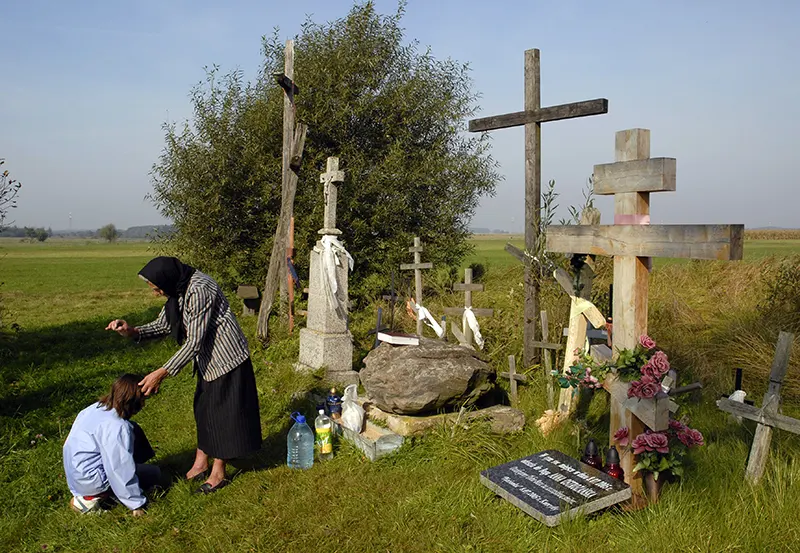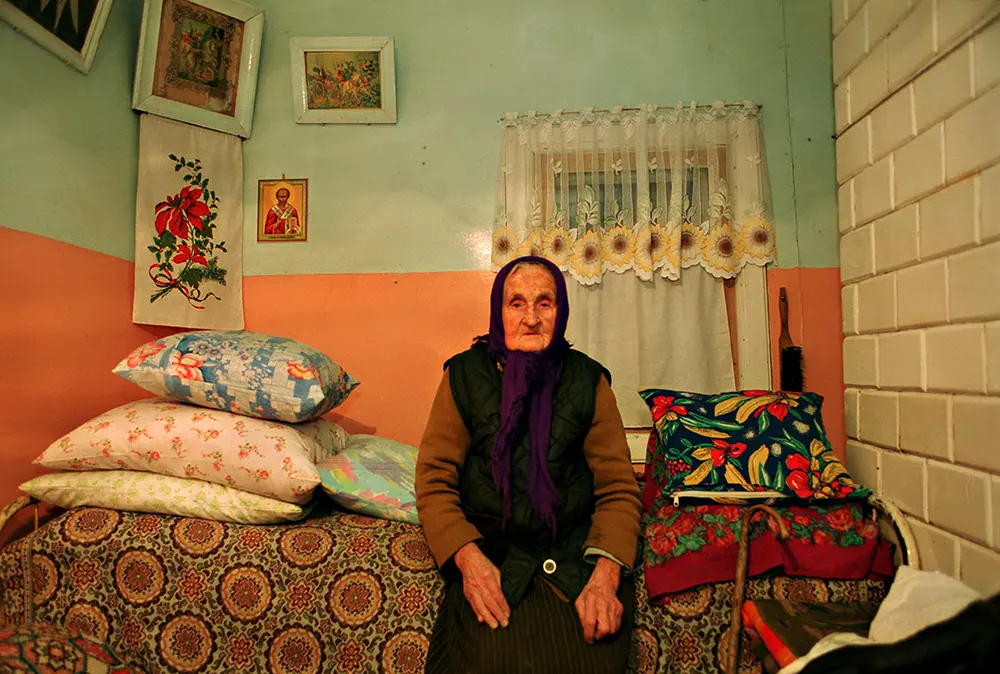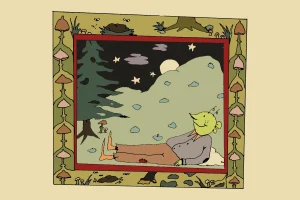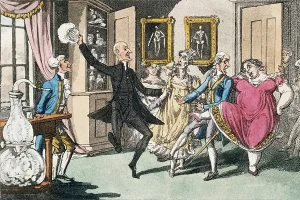After driving through the winter darkness, they arrived at a village not far from the Belarussian border. A man—desperate and barely moving from debilitating sciatica—slowly emerged from the car, placing one foot on the ground at a time, and hobbling towards the door of the hut. He was desperate for relief—having, to no avail, visited countless doctors and tried every painkiller available on the market. The whisperers were his last hope.
His friend waited in the cold outside the hut, with no idea what was going on inside. Forty-five minutes later, the man emerged, pale but walking effortlessly. All he said upon getting back into the car was, “Holy shit, let’s go.”
After driving back down the dark road in silence, just processing what had occurred, the man began trying to explain the seemingly inexplicable.
Inside the house was a woman who was blind and bed-bound. She told him to sit next to her bed. She didn’t ask questions. All of a sudden, he felt as if an invisible hand was rummaging inside of his brain. He lost all sense of time.
And then, it was over.

The woman said a prayer in a Belarussian dialect and asked him to leave. He stood up and walked away as if nothing had ever happened. But his pain was gone.
Such miraculous stories about whisperers are omnipresent in the border region of Podlasie in northeast Poland. The Polish word for whisperer—szeptucha—literally means “one who whispers.” Considered folk healers by some and charlatans by others, whisperers are often both respected and feared by local communities. They understand themselves to have a gift from God, which they channel through prayer and symbolic rituals. They’re usually Orthodox older women, although male or Catholic whisperers aren’t unheard of—and, by some educated estimates, there are only about a dozen left.
Stories about whisperers get featured in the local, national, and even broader European media. But these stories aren’t folklore of the olden days; most of them have taken place in the 21st century.
How to Grow Shrooms Bundle
Take Both of Our Courses and Save $90!
Historically, Podlasie has been a melting pot of cultures and religions. It’s where Catholic Christians blend with the Orthodox Christians, Jews, and Muslim Tatars who have assimilated themselves in the region. Additionally, Christianity took a long time to take root. There are reasons to think that even as late as the beginning of the 20th century, some villages of Podlasie kept to their pre-Christian beliefs and rituals.
READ: There’s a Worldwide Spike in Arrests of Plant Medicine Practitioners

Today, many Poles see the region as “behind” the rest of the country when it comes to economic and technological development. Małgorzata Anna Charyton, a local medical anthropologist and researcher of whisperers for well over a decade, explains that Podlasie is often referred to as “Poland B.” “Sure, we may not be as technologically advanced as the rest of the country,” she says, “but this also means we’re not as advanced in destroying the natural environment and our tradition.”
That may be one reason why the tradition of whisperers is still so alive here. Many people rely on them, particularly for solving ailments their doctors cannot. In the region, sometimes doctors even refer patients to a whisperer when they’re at a loss for how to proceed.
Charyton explains in the journal Progress in Health Sciences: “[Whisperers] mainly deal with the problems which from a medical point of view are not considered diseases, [but] so-called medically unexplained symptoms. In medical anthropology, they are described as folk illnesses and said to be a kind of ‘syndromes from which members of a particular group claim to suffer and for which their culture provides an etiology, a diagnosis, preventive measures, and regimes of healing.”

The main folk illnesses whisperers claim to heal are plica (kołtun in Polish), fear (lęk), rose (roża), the evil eye or charm (urok), nerves (nerw), and wind (wiatr). Wind and rose are believed to be connected, wind usually meaning muscle aches (an effect of being overexposed to wind) and rose, a type of skin irritation. All of these illnesses can be ascribed to a cause. For example, the wind usually arises from overexposure to cold and the evil eye results from someone else’s harmful presence or curse. The whisperer needs to know the cause so that they can undo it.
Most people go to a whisperer deliberately, to ask for help and prayer. But there are instances when healing allegedly happens as a “side effect” of a visit made for another purpose. This happened to Ewa Pirożnikow, a botanist, historian, and researcher of herbalists and healers in Podlasie.
“A few years ago, I went to a local herbalist to interview her about plant medicine,” she recalls. “At the time, I had this big red mark on my skin just below my neckline, which I was starting to worry about. I’d had it for over a year already when I went to see that woman. While talking to her, I was amazed by the depth of her knowledge and understood she wasn’t just a herbalist…A few days later, as I was taking a bath, I realized that the red mark had come off. I take this was a ‘bonus gift’ from that woman as she never even said anything about it.”
Other instances include the cases of mothers seeing a whisperer, and their children being healed as a result. Charyton remembers a woman in one of the regional meetings she holds, intended for locals and tourists to learn more about the whisperers, who spoke of her child’s recovery from an “incurable skin disease,” just hours after his mom saw a whisperer. Charyton says modern psychology and anthropology can explain this with ease.
READ: Huni Kuin Women Are Cultural Leaders in Plant Medicine—But They Haven’t Been Seen

“Child first establishes itself as part of the mother and only gradually, over time, separates itself from her,” she says. “But to a large extent, it’s so connected to the mother that the changes in her psyche directly affect the child’s wellbeing. A child’s disease is often a response to a mother’s unsatisfied need.”
From that point of view, the role of a whisperer is akin to psychological help. As Polish journalist Marek Kępa writes in Culture.pl, an online magazine covering Polish culture, “When you come to think of it, fright, charm, and nerve-plait are very similar in meaning to things like anxiety, nervousness, or stress disorder. It seems that folk treatment of these issues may be beneficial in some cases.” This isn’t far off from the view of the whisperers themselves, who, like many Indigenous healers, ultimately see all illnesses as originating from spiritual rather than biological causes.
While whisperers are still present in the cultural landscape of Podlasie, there are not nearly as many of them as a decade or two ago. Charyton says that when she was beginning her research a little over ten years ago, there were still areas where a whisperer could be found in every second village. Pirożnikow says that twenty years ago when she first started interviewing folk healers, she already heard she was late by a few years. Many respected whisperers had just died and didn’t leave successors.
Traditionally, before a whisperer passes away, they need to transmit their gift. It is said that if they don’t, they won’t be able to die peacefully. There’s a well-known story circulating the region about an old whisperer who couldn’t leave this world because she didn’t share her gift with anyone. In painful agony, she asked for a hole in the roof of her house to be made so that her soul could finally leave her body. Once her wish was granted, she died calmly.
These days, it’s challenging for whisperers to find successors. Most whisperers don’t charge for their services so it’s just not considered a viable way of living in today’s economy.
Traditionally, whisperers might take a small gift such as a bar of chocolate, fabric, or cherry vodka—but most don’t explicitly ask for money.

Despite the decline in whisperers, there remain people in villages who seek their services. Pirożnikow remembers visiting a village in Podlasie, and the women she met telling her that since the whisperers were gone, the women needed to “incense” themselves—“because we cannot live without it.” Amid this void, much like in other parts of the world with traditional healers, phony whisperers have emerged to capitalize on that need as a way to profit in the region. They are (usually) women who sell organic handmade soap, cosmetics, and amulets, and brand them as “whisperer services.”
“This is adding new meaning to the traditional term ‘whisperer,’” says Charyton. “The word is being used by a new generation, people who aren’t necessarily traditional folk healers from Podlasie. Is this right or wrong? That’s not for me to tell. As an anthropologist, I acknowledge that everyone is entitled to their own truth.”
*This article was originally published in DoubleBlind Issue 7.

DoubleBlind is a trusted resource for news, evidence-based education, and reporting on psychedelics. We work with leading medical professionals, scientific researchers, journalists, mycologists, indigenous stewards, and cultural pioneers. Read about our editorial policy and fact-checking process here.

DoubleBlind Magazine does not encourage or condone any illegal activities, including but not limited to the use of illegal substances. We do not provide mental health, clinical, or medical services. We are not a substitute for medical, psychological, or psychiatric diagnosis, treatment, or advice. If you are in a crisis or if you or any other person may be in danger or experiencing a mental health emergency, immediately call 911 or your local emergency resources. If you are considering suicide, please call 988 to connect with the National Suicide Prevention Lifeline.




